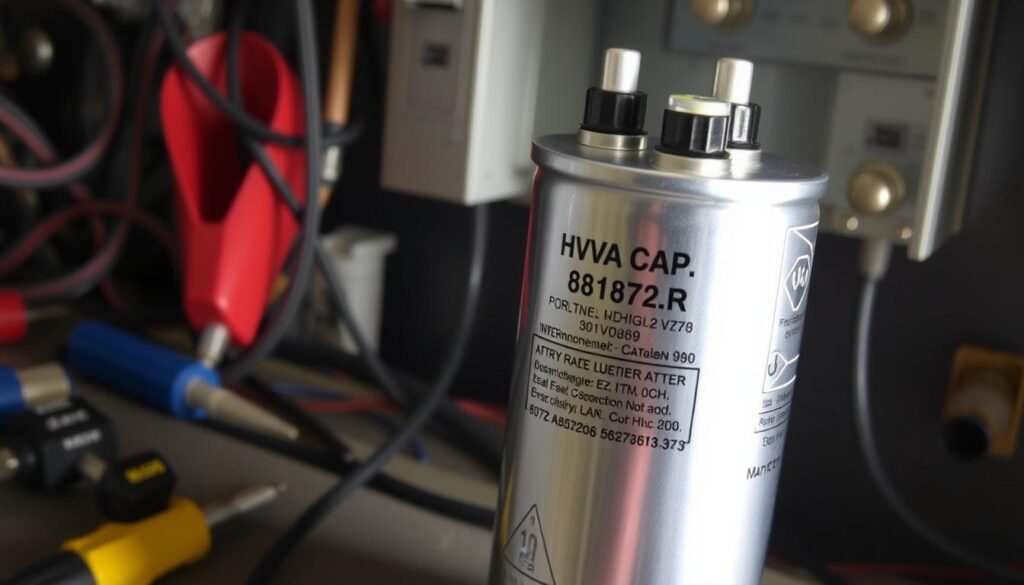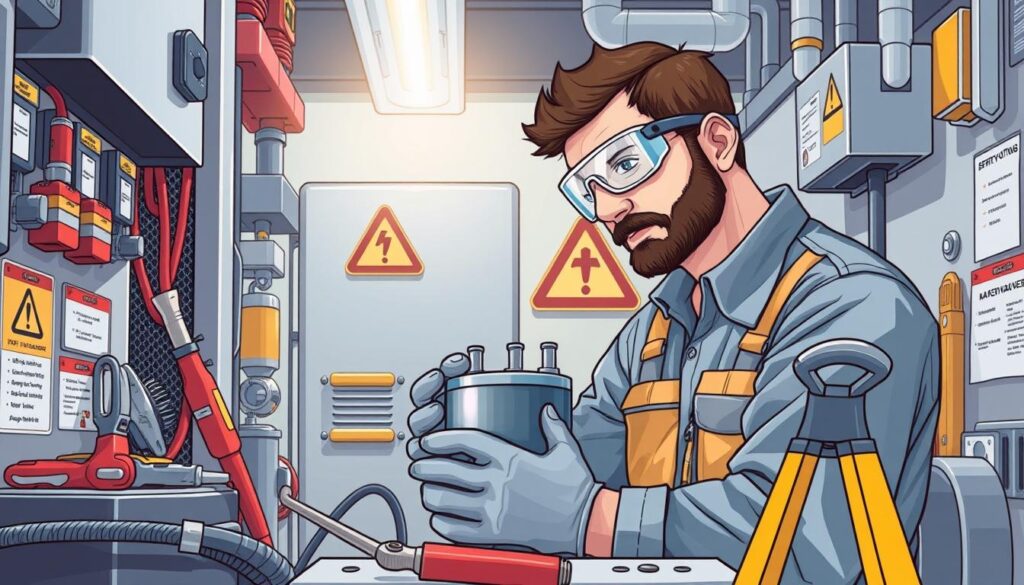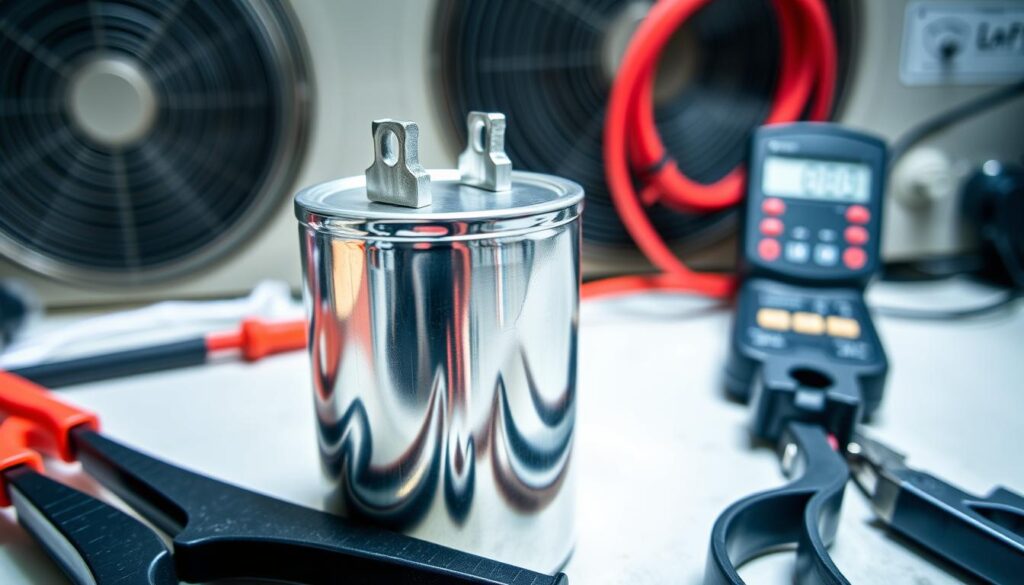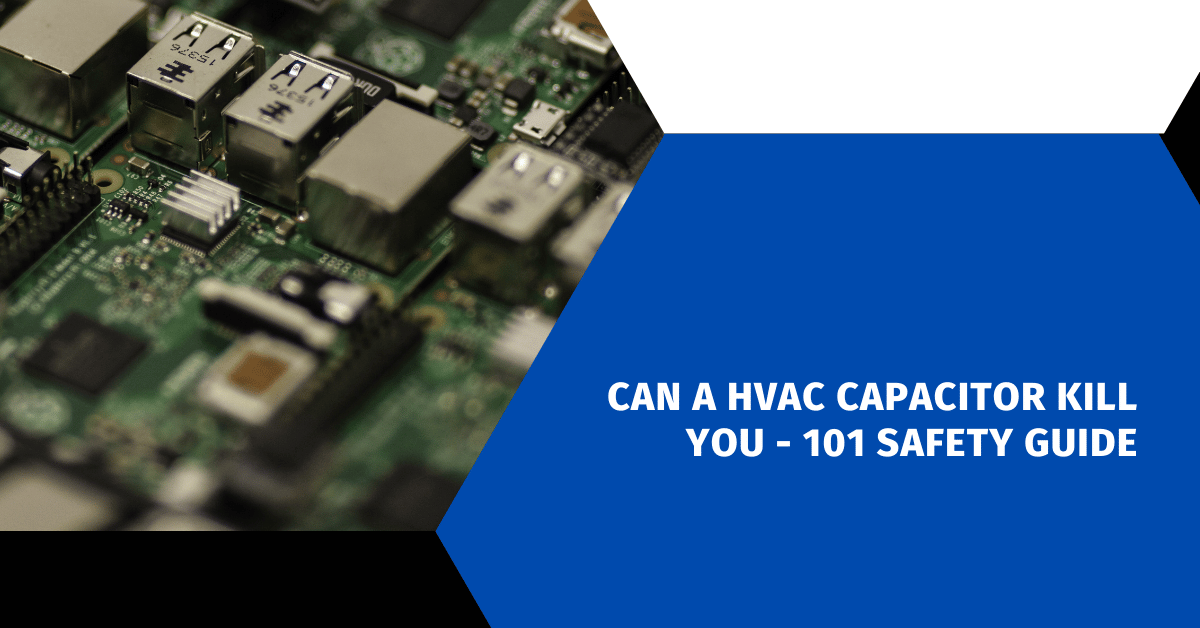Affiliate Disclosure
HVAC Guide Guys is a participant in the Amazon Services LLC Associates Program, an affiliate advertising program designed to provide a means for sites to earn advertising fees by advertising and linking to Amazon.
Can a HVAC Capacitor Kill You? Ever thought about the danger of the small capacitor in your HVAC system? These parts might look harmless, but they can hold a lot of electrical charge. Even when the power is off, they can still be deadly. This makes HVAC capacitor safety very important for homeowners and technicians.
In this guide, we’ll explore the dangers of HVAC capacitors. We’ll also share important safety tips to keep you and your family safe.

Key Takeaways
- HVAC capacitors can store a potentially deadly electrical charge, even when the power is off.
- Mishandling these components can result in a fatal electric shock.
- Proper safety precautions are crucial when working with HVAC systems and their capacitors.
- Hiring a professional HVAC technician is highly recommended for any work involving capacitors.
- Understanding the dangers and taking the necessary safety measures can help prevent serious accidents.
Table of Contents
Understanding HVAC Capacitors and Their Function
HVAC capacitors are key parts of heating, ventilation, and air conditioning (HVAC) systems. They store and release electrical energy to start motors and keep the HVAC system running right. Knowing about HVAC capacitors is important for safe handling and upkeep.
Basic Components of HVAC Capacitors
HVAC capacitors have two metal plates and an insulating material like paper or plastic. This setup lets them store and release electrical charge. This charge is needed to start and run the motors in an HVAC system.
Role in HVAC System Operation
Most HVAC systems use capacitors to power the AC system’s motors at start-up. These capacitors are measured in voltage and microfarads (MFD), usually between 5 MFD and 80 MFD. They help the compressor and fan motors get going, ensuring the system works well and reliably.
Types of Capacitors Used in HVAC Systems
HVAC systems use different types of capacitors. Start capacitors give the initial power boost to start the motors. Run capacitors keep the motors running. Dual run capacitors have separate ratings for the fan motor and compressor, improving both components’ performance.
| Capacitor Type | Function | Typical Voltage and Microfarad Ratings |
|---|---|---|
| Start Capacitor | Provides initial power boost to start motors | 370V to 440V, 120 MFD to 500 MFD |
| Run Capacitor | Maintains ongoing operation of motors | 370V to 440V, 5 MFD to 80 MFD |
| Dual Run Capacitor | Separate ratings for fan motor and compressor | 370V to 440V, 5 MFD to 80 MFD each |
Knowing about HVAC capacitors is key to keeping your HVAC system running smoothly.
Explore Our HVAC Shop
Looking for top-rated HVAC tools, parts, and accessories? Visit our shop and find the perfect solution for your needs.
Visit the ShopCan a HVAC Capacitor Kill You – Critical Safety Information
HVAC capacitors can be very dangerous if not handled carefully. They store electrical charge, even when not connected to power. This makes them a serious risk for electric shock. A capacitor can let currents of up to 115mA flow, which is enough to be fatal.
When working on HVAC systems, it’s important to know about the capacitor safety risks and electrical shock hazards. Ignoring these dangers can lead to very bad outcomes. Keeping HVAC safety in mind is crucial when working on these systems.
To stay safe, always follow strict safety rules when dealing with HVAC capacitors. Getting proper training, using the right tools and PPE, and understanding the system’s parts are key. These steps help ensure safe work practices.
“A single mistake when working with an HVAC capacitor can result in a potentially lethal electric shock. Safety should always come first when servicing these systems.”
By understanding the risks and taking the right precautions, everyone can work safely with HVAC capacitors. Always stay alert and put safety first. This way, we can avoid serious accidents and keep ourselves and others safe.
The Dangers of Electrical Discharge from Capacitors
Capacitors are key in HVAC systems but can be risky if not handled carefully. They store high voltages, even when not connected to power. The time they hold this charge can be quite long.
Capacitors over 0.01uF can cause problems, especially at high voltages. Even 70V can be deadly in some cases. Hobby electronics use capacitors that hold a lot of energy. Remember, milliamps are more dangerous than voltage in electrical shocks.
Discharging 50V from a 130,000uF capacitor can make a sizzling sound. This shows how dangerous it can be. Using bleeder resistors is key to safely releasing this energy. Choosing the right bleeder resistor is crucial for quick and safe discharge.
The time it takes for a capacitor to discharge depends on its size and the bleeder resistor. Things like the person’s constitution and how wet their fingers are can affect the danger of an electrical shock. So, it’s very important to be careful when working with capacitors.
Voltage Storage Capabilities
Capacitors can hold high voltages for a long time, even after being turned off. This stored energy can be very dangerous. It can cause severe electrical shocks or even be fatal.
Duration of Charge Retention
The time a capacitor holds its charge depends on its size and type. Some can keep their charge for minutes or even hours after being turned off. This means there’s always a risk of electrical discharge.
Potential Current Flow Risks
When a capacitor discharges, the current can be very dangerous. Some capacitors can let up to 115mA flow, which is enough to be fatal. This shows how important it is to handle and discharge capacitors carefully.
“Even a 12V DC supply can be lethal under certain conditions, so it’s crucial to exercise caution when working with any electrical system.”
Safety Measures When Handling HVAC Capacitors
When working with HVAC capacitors, safety is key. These parts hold a lot of electrical energy. They can be dangerous if not handled right. So, take steps to keep yourself safe and maintain your HVAC system well.
Always assume the capacitor is charged until you check it. Never touch the capacitor’s terminals without making sure it’s safe. Use insulated tools and wear gloves and safety glasses to avoid electrical shocks.
- Discharge the capacitor before you start work. You can do this by connecting a resistor to slowly release the energy.
- Follow the manufacturer’s guidelines and industry best practices for safe handling and maintenance of HVAC capacitors.
- Check capacitors for damage like bulging, leaks, or cracks. Replace them if needed to keep your system efficient and safe.
- Make sure the new capacitor fits your HVAC unit and meets the needed specs.
- If you’re unsure about capacitor handling or maintenance, talk to a licensed and experienced HVAC technician.
By following these safety steps, you can reduce risks when handling HVAC capacitors. This ensures your HVAC system works right. Remember, electrical precautions and capacitor handling safety are crucial for a safe and well-kept HVAC unit.
Explore Our HVAC Shop
Looking for top-rated HVAC tools, parts, and accessories? Visit our shop and find the perfect solution for your needs.
Visit the ShopProper Tools and Equipment for Capacitor Handling
Working with HVAC capacitors requires the right tools and safety gear. You need insulated gloves, safety glasses, and non-conductive footwear to protect yourself. Also, tools like a capacitor discharge stick or resistor are key for safely removing energy from capacitors.
Essential Safety Gear
- Insulated gloves: These gloves protect you from electrical shocks, keeping you safe from live components.
- Safety glasses: They shield your eyes from sparks, debris, or other hazards during capacitor handling.
- Non-conductive footwear: Shoes with non-conductive soles help avoid electrical current and reduce electrocution risk.
Discharge Tools and Their Usage
Using the right discharge tools is vital for safely removing energy from capacitors. The capacitor discharge stick and the resistor are two common tools for this job.
- Capacitor Discharge Stick: This tool safely discharges capacitors by providing a controlled path for energy to dissipate. It has a high-resistance element that slowly drains the capacitor’s charge, reducing the risk of sudden discharges.
- Resistor: A resistor can also discharge a capacitor. By connecting the capacitor terminals to a resistor, the stored energy is dissipated through the resistor. This allows for a controlled and safe discharge process.
Always follow the manufacturer’s instructions and safety guidelines when using these tools. This ensures your safety and the proper functioning of your HVAC system.
“Proper tools and equipment are essential when handling HVAC capacitors to ensure your safety and the integrity of the system.”
Explore Our HVAC Shop
Looking for top-rated HVAC tools, parts, and accessories? Visit our shop and find the perfect solution for your needs.
Visit the ShopCommon Accidents and Prevention Strategies
HVAC systems need capacitors to work right. But, these parts can be very dangerous if not used carefully. Electrical shocks, burns, and even explosions can happen. To avoid these risks, it’s important to follow safety rules and keep HVAC systems in good shape.
Every year, electrical injuries from HVAC capacitors send thousands to the hospital and kill hundreds in the U.S. These dangers often happen at work. In 2015, HVAC and plumbing workers faced over 37,000 accidents and 29 deaths.
- Not following safety steps, like lockout/tagout, can lead to serious harm or death for HVAC workers.
- Untrained mechanics have even lost limbs when equipment turned on by mistake during repairs.
- Employers must enforce lockout/tagout rules to keep workers safe while fixing or cleaning HVAC gear.
Keeping HVAC systems well-maintained and checked can prevent accidents caused by bad capacitors. By being careful and following safety rules, HVAC experts can lower the chance of HVAC accidents and capacitor safety incidents.

Working with HVAC capacitors safely is key. Proper training, wearing the right safety gear, and following discharge steps are vital. They help keep HVAC workers and their clients safe.
Health Risks Beyond Electric Shock
Electric shock from HVAC capacitors is a known danger. But, there are other health risks to consider. Chemicals from a leaking capacitor can be harmful. Also, the smoke and fumes from overheating capacitors can be toxic if breathed in.
Chemical Exposure Concerns
HVAC capacitors have chemicals like PCBs, mineral oil, and insulating fluids. If they leak, these chemicals can harm you. Wearing protective gear and cleaning up carefully are key to avoid chemical exposure.
Smoke and Fume Hazards
Overheated HVAC capacitors can release harmful smoke and fumes. These can include carbon monoxide and hydrogen chloride. Breathing in these fumes can lead to health problems. It’s important to have good ventilation and wear masks when working with HVAC systems.
Even though the industry is working to use safer materials, risks still exist. It’s crucial to be careful and follow safety rules when working with HVAC capacitors. This protects both workers and building users.
| Hazard | Potential Health Effects | Recommended Safety Measures |
|---|---|---|
| Chemical Exposure | Skin irritation, respiratory issues, long-term health problems | Use proper protective equipment, follow cleaning procedures |
| Smoke and Fumes | Respiratory distress, headaches, long-term health effects | Ensure adequate ventilation, use respiratory protection |
“Proper training, safety protocols, and vigilance are essential when dealing with HVAC capacitors to ensure the protection of both technicians and building occupants.”
Explore Our HVAC Shop
Looking for top-rated HVAC tools, parts, and accessories? Visit our shop and find the perfect solution for your needs.
Visit the ShopProfessional vs DIY Capacitor Handling
Handling capacitors in HVAC systems needs careful attention. The best choice is professional services for safe and correct replacement.
HVAC technicians are trained to handle capacitors safely. They use safety gear like insulated gloves and tools. They also follow strict protocols to install capacitors correctly, avoiding damage to the HVAC system.
DIY risks are high when replacing capacitors. Capacitors can still be dangerous even when the power is off. Without the right knowledge and tools, DIY attempts can lead to wrong installation. This can harm the HVAC system’s efficiency and lifespan.
For your safety and the HVAC system’s health, it’s best to use professional HVAC services for capacitor replacement. Professionals have the skills and tools to do the job right and safely.
| Professional HVAC Services | DIY Capacitor Handling |
|---|---|
| Trained technicians with specialized knowledge | Potential for electric shock and system damage |
| Proper safety equipment and tools | Lack of necessary tools and protective gear |
| Adherence to industry standards and protocols | Risk of improper installation and system malfunction |
| Efficient and effective capacitor replacement | Compromised HVAC system performance and lifespan |
Choosing a qualified professional for capacitor replacement is the safest and most reliable option. It ensures your HVAC system works well for a long time.

Emergency Response to Capacitor Accidents
If a capacitor accident happens, acting fast is key. You might get shocked, burned, or exposed to harmful fumes. Quick action can help a lot and ensure you get medical help right away.
First Aid Measures
First, if you get shocked by a capacitor, turn off the power if it’s safe. Call for help and start CPR if the person is not moving.
For burns, cool the area with water right away. Don’t use ointments or creams as they can make it worse.
When to Seek Medical Attention
- Get medical help right away for any electrical shock, no matter how small it seems. Even a little shock can be serious.
- If a burn is big, deep, or covers a lot of skin, get medical help fast.
- Smoke or fumes from a broken capacitor are dangerous too. Even if you don’t feel sick, see a doctor.
Your safety is the most important thing. If you’re worried about a capacitor accident, call for help or see a doctor. Quick action can prevent more harm and help you heal faster.
| Metric | Value |
|---|---|
| Voltage | Power supply units get electricity from a 208-volt wall outlet. This is then changed to 5 kilovolts stored in capacitors. |
| Charged Capacitor | The stored charge can release up to 200 milliamps of current. This is a big risk for people near open power supplies. |
| Incident Response | The incident caused an electric shock that went into the left hand and out the right. The person was taken to the hospital for check-ups and didn’t have serious injuries. |
| Preventive Measures | At first, there were no rules for electrical safety in the shop. A Job Safety Analysis (JSA) was done to make repair work safer. |
| Lessons Learned | Only trained people should handle electrical stuff. Make sure capacitors are discharged before working nearby with the right tools. |
Explore Our HVAC Shop
Looking for top-rated HVAC tools, parts, and accessories? Visit our shop and find the perfect solution for your needs.
Visit the ShopLegal Requirements and Industry Standards
Handling HVAC capacitors requires knowing the legal rules and industry standards. These include HVAC regulations, capacitor safety standards, and electrical code compliance. They are key to using these devices safely and responsibly.
The Occupational Safety and Health Administration (OSHA) has set clear rules for electrical safety. These rules cover how to handle and maintain HVAC capacitors. They specify the safety steps and protective gear needed for high-voltage work. Following OSHA’s electrical safety standards is a legal must and a crucial safety step for everyone involved.
The National Electrical Code (NEC) also has detailed guidelines for HVAC systems, including capacitors. Following NEC standards ensures capacitors are installed correctly. This reduces the risk of electrical dangers and system failures.
Also, HVAC manufacturers have their own safety rules for their capacitors. Knowing these guidelines helps you handle capacitor maintenance and replacement safely. It protects you and the equipment.
By following HVAC regulations, capacitor safety standards, and electrical code rules, you can avoid accidents. This also helps prevent legal issues and ensures HVAC systems work safely and reliably. Keeping these standards in mind is essential for a safe and efficient HVAC environment.
“The failure of a capacitor can quickly lead to the damage of expensive components like compressors in HVAC systems, underscoring the importance of adhering to industry standards and best practices.”
Following HVAC regulations, capacitor safety standards, and electrical code rules is not just legal. It’s also vital for responsible HVAC maintenance and operation. By focusing on these guidelines, you can prevent accidents, protect valuable equipment, and keep HVAC systems safe and efficient for everyone.
Conclusion
HVAC capacitors are very dangerous and should be treated with caution. They can give out deadly electric shocks, even when not connected to power. It’s important to know the risks and follow safety rules when working with HVAC systems and their capacitors.
Keeping HVAC systems in good shape and learning about HVAC safety summary, capacitor handling best practices, and electrical hazard awareness is key. This helps avoid accidents and keeps HVAC workers and homeowners safe. By focusing on safety and following industry standards, we can lower the risks from HVAC capacitors.
Everyone involved in HVAC needs to take safety seriously. By working together, we can make the HVAC world safer for all. This means spreading the word about safety and using strong safety measures.

